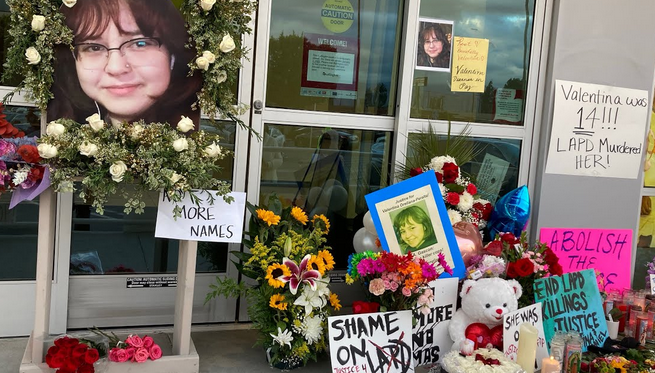Few topics have vexed and constrained African Americans, as much and as long as skin color and attendant bugaboos like “good hair.†Only yesterday, within living memory, Black was once “beautiful.†Today however, even as the nation seriously contemplates electing our first Black President, simply depicting Michelle Obama with an afro, quite apart from her adopting one, is widely perceived as a threatening political statement.
[Notes From The Frontline]
What’s so wrong with CNN’s special report, Black In America?
Strangely, the answer, having to do with accuracy, versus exaggeration, amounts to a matter as ordinary as a tomato.
In the USA, when it concerns those who are Black and poor, is there really any sense in presenting things, not merely as bad, but much worse than they really are? Is this what it takes to elicit empathy, from Blacks and Whites who are better off?
It used to be, that conducting tours in Harlem I’d begin by announcing, “In my fabled neighborhood, today, you will see things both, more magnificent and more wretched, than you have ever imagined.”
I soon stopped. Gradually, it dawned on me, irrespective of race, most visitors thought of Harlem as some defamed focus of infamy. Nothing they might discover here, as a consequence, could ever, even remotely, be more derelict or depraved than what they already eagerly expected.
Suffering from labored breathing, walking with a stick, a Harlem grandmother, whose ill health and extra weight makes her look, at 60, some 10 to 15 years older, has a problem. She bemoans the routine ordeal of having to travel 20 blocks South, to 110 th Street at Broadway, in order to obtain a tomato or any other “fresh” produce.
Now then, I’m the first to concede, much remains that’s terribly wrong. For most who live in Harlem, day to day life can often be a succession of frantic, stress-filled struggles. Gentrification and the $900,000 average price tag of a new condo, on top of sub-standard schools and inadequate health care, are taking a terrific toll.
For a fact, unlike Downtowners, we’ve yet to enjoy the convenience of high quality green-grocers on virtually every corner. But, river to river, all along the way from grandma’s house, around 138th Street, to Cathedral Parkway, aka 110th Street, there are, if not plenty, at least many alternate suppliers of leafy greens.
Apart from recent supermarket imports, Fairway, Path-mart or Citarella, they include a dozen or so newly improved long term local groceries. Here, now, even once scarce exotic offerings such as skim milk and yogurt along with acceptable spinach and broccoli can be found in abundance.
That Soledad O’Brien, the lovely 42-year old anchor and special correspondent who reports CNN’s 2-night special feature, failed to challenge this glaring discrepancy, only makes one wonder: why?
At its best, however superficially, “Black In America” at least raises some important subjects. There are issues, long shrouded in taboo and shame for Blacks, which are seldom discussed above a whisper and in never among “mixed company.” White folks are to be prevented from learning our “secrets”; at all cost.
Few topics have vexed and constrained African Americans, as much and as long as skin color and attendant bugaboos like “good hair.” Only yesterday, within living memory, Black was once “beautiful.” Today however, even as the nation seriously contemplates electing our first Black President, simply depicting Michelle Obama with an afro, quite apart from her adopting one, is widely perceived as a threatening political statement.
Biracial, and elegantly polished, Soledad O’Brien is sure to strike some as conspicuously jarring in her role of revealing the state of Black America to the world. Both visually and in terms of relative privilege, she projects a nearly-White presence examining the lives and misery of people, seemingly, mostly, far removed from her own experience.
This is not an observation that’s made lightly. Certainly, as a light-skinned, educated African American I’ve had more than my share of such criticism. Challenges as to the authenticity of my Blackness, are periodically raised by Blacks as well as Whites. And, it’s a complicated business too, when you consider the history of African Americans and our relation to, the national melting pot.
Assimilation; this is a process by which newcomers from around the globe, are socialized, indoctrinated and refined. Shedding the most obvious and objectionable associations of alien origins, most immigrants emerge, if not purely White and so, as “good as gold,” at least with a sufficient plating of acceptable values and behaviors, to be deemed White, on an honorary basis.
Through diligence and hard work, Jews, from “beyond the Pale,” the “black Irish,” Latinos and even, Asians have all been known to effectively make this transition. Moreover, it has been an effort with an outcome of incalculable value, affording them all some measure of equal access to our national dream of prosperity and well being.
Only, for our African ancestors, whom the White elite came to regard as their definitive opposites, Blackness proved to be an impenetrable barrier to any hope of the same kind of beneficial blending in. That is, except for the mitigation of Blacks alloying our dreaded Blackness, with Whiteness.
When in the 1890’s my great-grandmother’s father came riding along, the drill of an abusive system was already long established. Gray-haired, the store keeper from Columbus Georgia, Michael Van De Lacey, was 73. He and his wife, also an Irish immigrant, had 12 “legitimate children.”
Emma Bellamy, who worked as a serving girl, or “waitress” in their household, was only 16. She was walking home as he approached commanding, as calm and quietly as if commenting on the weather, “ Emma, lie down, there in that ditch, you know what you have to do.. ”
Along with painful depths of disgrace came several tangible advantages. Christened Willie Mae Jones, Mamma Willie, my father’s father’s mother, was educated at Barber Lee Seminary and Spellman College. She could and sometimes did, in order to ride the bus or train and to work in a Northern industrial plant, pass for White. Her mother, married to a Black man, Frank Jones, was given rental houses and a funeral home.
How, given such circumstances, this nuanced mix of concern, contempt, close intimacy with and alienation from Whites, could Blacks hope to avoid a conflicted relationship about color or class?
Even in our time, delusions of superiority, based on “lightness” or attainment, persist. If once a sad victim, society has, with repeated, savage suitability, at least helped to save me from my worse self.
As luck would have it, it was the hurtful, guilt-ridden process of “coming out,” accepting myself as a homosexual, that led to me embracing being Black.
“Are you going to be a good little colored boy today?”, Mamma Willie asked once, when I was four. “No! I’m going to be a good little White boy, cause I’m White, just like you!,” was my frightened response.
Thanks to instruction, on TV, through the example of Dennis the Menace and Leave it to Beaver, none of my great-grandmother’s teasing nor an explanation that she wasn’t White and neither was I, made the slightest difference. I ran home sobbing uncontrollably, straight into my “brown skinned” mother’s comforting arms.
By Junior High School, occasionally, White classmates would apologize for calling someone else “Nigger”, explaining, “sorry Mike, I forgot; cause, you’re like one of us man.”
Perhaps, there is no come-uppance so severe, as believing that belonging to some group or another absolves one from the race-based attack of an imagined ally.
In 1985, having just returned from study in England, I decided to attend a newly-opened Gay bar in Cleveland. Written up in the Gay paper, it was Downtown and described as reminiscent of Styx’s, a popular spot in the East Village.
“Sorry, I can‘t serve you. This is a private club, for members only,” the flustered barman informed me. Had not two White acquaintances ventured in at that moment, I would have certainly left. But, they insisted on buying me a drink and the barman happily took their order. Until that is, he realized that the Bombay and tonic, with two slices of lime, was intended for me.
There ensued a hurried and hushed conference across the room with the manager. It seemed to involve more pointing and gesturing than talk. At the conclusion, the barman returned and looked at the floor. “Sorry,” he informed, “you can stay or go as you like. We just opened a new place here. We want to keep it nice, but it’s hard with the people in this area. It’s impossible to let in some and not others and I’m sorry, but I just can’t tell the difference…”
Up until that very instant, I’d have insisted with passion, to the barman or anyone else, that I, and many like me, by virtue of breeding and cultivation, our Brooks Brother’s tweeds and silk bow ties, represented an easily distinguishable difference from the Black masses.
It was only by viewing myself from a different vantage point, through the barkeeper’s eyes, that these distinctions disappeared for me; for good.
To comment or to subscribe to or advertise in New York’s leading Pan African weekly investigative newspaper, or to send us a news tip, please call (212) 481-7745 or send a note to [email protected]
Also visit out sister publications Harlem Business News www.harlembusinessnews.com and The Groove music magazine at www.thegroovemag.com
“Speaking Truth To Empower.”











